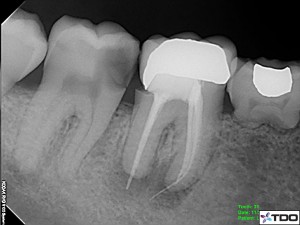…when you look at this radiograph?
Controlling working length is a fundamental of endodontic therapy.
There are a few methods I will use to determine ideal working length:
1. Working length radiograph
2. Apex locator(RootZXII)
3. Tactile detection
4. Paper point technique
Sometimes I will use all of these, sometimes just one or two. However, I always take a working length radiograph at some point during treatment. I am aware that many people forgo the radiograph and solely rely on other methods. This doesn’t make sense to me. In the end, we judge endodontics based on the postoperative radiograph. Why wouldn’t you “test” your hypothesis prior to publishing your results?
I am a huge fan of the apex locator. Particularly the RootZXII. Through thousands of cases, this device has performed admirably. However, you have to understand how the apex locator works to get the most out of it. Essentially, the lip clip establishes the electrical resistance of the buccal mucosa, which is in theory identical to that of the periodontal ligament. The metal file is a “perfect” conductor and as such when it touches the periodontal ligament while hooked up to the apex locator, the circuit closes and you hear a full tone. Not quite that easy, but that’s my off the cuff explanation.
The apex locator is most effective for me later in the shaping procedure. Initially, it often acts squirrely. Why? I have my theories, but the predominant one is that the file tip is electrically “looking” for the PDL. Because of anatomic structures, tissue, sludge, etc., looking is very difficult early on. As the canal is cleaned and shaped “visibility”of the PDL improves, and when we reach the point where we have a clear, repeatable path to the PDL, the apex locator is extremely accurate in one way. When you hear full tone, you are at the PDL. The numbers on the side, the fast beeping…no. I am only interested in the full tone.
Once I have a reliable, repeatable value, I get radiographic confirmation and proceed with treatment.
Anyone who knows me, knows that I’m not about beating down other practitioners. As providers, we are all on the same team. But some cases provide us with a clear illustration of why we need to be doing the things we are or are not currently doing. The contrast of tooth #30 and 31 does that in the postoperative radiograph.
The best way to avoid this kind of untoward event when performing endodontic treatment is to establish and then verify working length prior to obturation. The work we do and our attention to detail says a lot about who we are.

